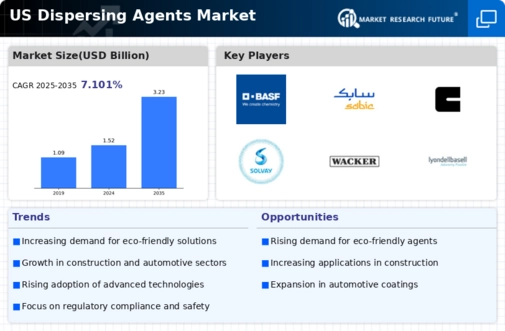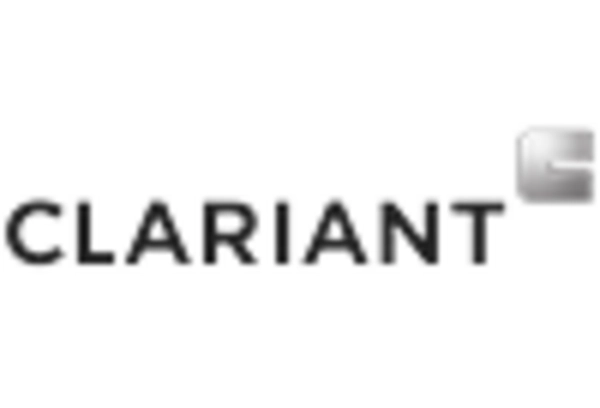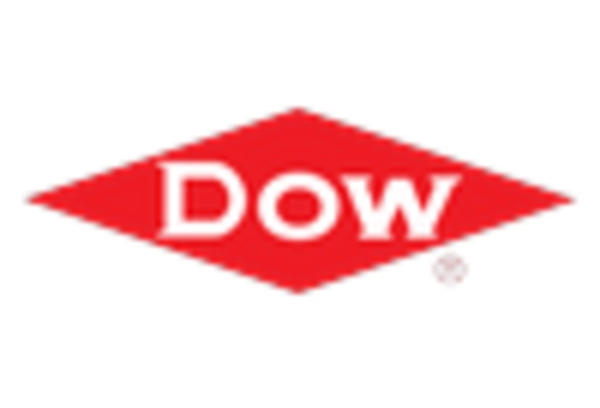Growth in the Construction Sector
The construction sector is a significant driver of the dispersing agents market, with ongoing infrastructure projects and residential developments fueling demand. The US construction industry is projected to reach a value of $1.8 trillion by 2026, creating a substantial market for dispersing agents used in cement and concrete applications. These agents enhance the workability and durability of construction materials, making them indispensable in modern construction practices. As the trend towards sustainable building materials continues, the use of eco-friendly dispersing agents is likely to gain traction, aligning with industry goals for reduced environmental impact. Additionally, the increasing complexity of construction projects necessitates the use of advanced dispersing agents to ensure optimal performance and compliance with regulatory standards. This growth in the construction sector is expected to have a lasting impact on the dispersing agents market.
Expansion of the Plastics Industry
The dispersing agents market is significantly influenced by the expansion of the plastics industry in the US. With a market size exceeding $400 billion, the plastics sector is a major consumer of dispersing agents, particularly in the production of masterbatches and polymer composites. These agents are essential for achieving uniform dispersion of pigments and fillers, which is critical for the performance and aesthetics of plastic products. As the demand for lightweight and durable materials increases, particularly in automotive and packaging applications, the need for effective dispersing agents is likely to rise. Furthermore, innovations in polymer formulations are expected to drive the adoption of advanced dispersing agents, thereby propelling growth in the dispersing agents market. This trend suggests a symbiotic relationship between the two industries, with each driving advancements in the other.
Rising Demand in Paints and Coatings
The dispersing agents market is experiencing a notable surge in demand from the paints and coatings sector. This industry is projected to grow at a CAGR of approximately 4.5% through 2026, driven by the increasing need for high-performance coatings in construction and automotive applications. Dispersing agents play a crucial role in enhancing the stability and performance of these coatings, thereby improving their marketability. As manufacturers seek to meet stringent environmental regulations, the use of eco-friendly dispersing agents is becoming more prevalent. This shift not only aligns with sustainability goals but also enhances product performance, making it a key driver in the dispersing agents market. The growing trend towards high-quality finishes in consumer products further amplifies the need for effective dispersing agents, indicating a robust growth trajectory for this segment of the market.
Technological Innovations in Manufacturing
Technological innovations in manufacturing processes are emerging as a pivotal driver for the dispersing agents market. The introduction of advanced formulations and production techniques enhances the efficiency and effectiveness of dispersing agents, leading to improved product performance. For instance, the development of high-shear mixing technologies allows for better dispersion of agents, resulting in superior stability and consistency in end products. This is particularly relevant in industries such as inks and adhesives, where performance is paramount. As manufacturers increasingly adopt these technologies, the demand for high-quality dispersing agents is expected to rise. Moreover, the integration of automation and digitalization in manufacturing processes may streamline operations, further boosting the dispersing agents market. This trend indicates a shift towards more sophisticated production methods, which could redefine industry standards and expectations.
Rising Consumer Preferences for High-Quality Products
Consumer preferences are shifting towards high-quality products across various sectors, which is influencing the dispersing agents market. Industries such as cosmetics, food, and pharmaceuticals are increasingly prioritizing product quality and performance, necessitating the use of effective dispersing agents. These agents are crucial for achieving uniformity and stability in formulations, which is particularly important in applications like emulsions and suspensions. As consumers become more discerning, manufacturers are compelled to invest in high-performance dispersing agents to meet these expectations. This trend is likely to drive innovation and development within the dispersing agents market, as companies strive to enhance product quality and differentiate themselves in a competitive landscape. The growing emphasis on quality is expected to sustain demand for advanced dispersing agents, further propelling market growth.

















Leave a Comment